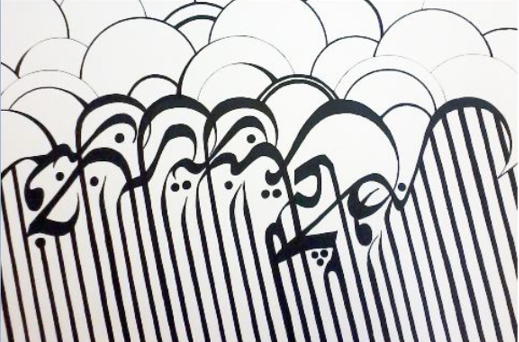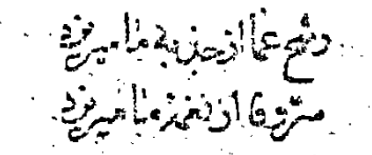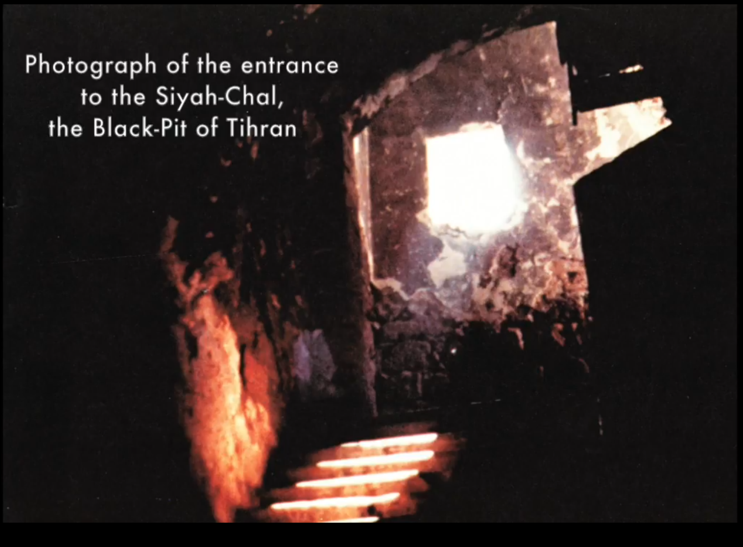قصيده رَشْح عَمَاء
SELECT TEXTS AND TRANSLATIONS
OF
AN EARLY POEM OF BAHĀ'-ALLĀH
رَشْح عَمَا
THE RASHḤ-I `AMĀ'

("THE SPRINKLING OF THE THEOPHANIC CLOUD")
Introduction, Translations and Commentary Pt. 1
Stephen N. Lambden UC Merced.
First translated 1982, revised 1990s, 2006 and now being further revised 2020.
In progress and under revision: Last revised March 31st 2015 +30-01-2017 +08-01-2021
The Persian Qaṣīdah (Ode) Rashḥ-i `amā' ("The Sprinkling of the Theophanic Cloud")
First and Last lines
Zayn al-Muqarrabin ms (p.68).

INBMC 30:165 :
![]()
Opening hemistitch of line 1 :
رَشْح عَمَاء از جَذبه مَا مِيرِزَد
On account of our Rapture the sprinkling of the Theophanic Cloud rains down.
The Mystery of Fidelity pours forth from Our melody.
In select ms. the closing couplet 19 or 20 reads:
INBMC 30:167.
![]()
اين طفّح ظهوراست اين رشح طهوراست
غنّ طيوراست اين كز عين فنا ميريزد
This is the overflowing Theophany! This is the sprinkling of Manifestation!
Such is the warbling of the heavenly birds which sing nigh the wellspring of mystical death
Some Introductory Notes (1984+ revised 2020)
Bahā'-Allāh's Rashḥ-i `amā’ is a Persian Qasida, a polythematic monoryhmed poem of nineteen or twenty (mss. vary) couplets which take their name from the opening words of its first hemistich. Widely though somewhat incorrectly regarded by Bahā'īs as the earliest extant example of divine revelation (Bahā'ī scripture), it was not at all the first sacred type communication of the founder of the Baha'i religion during his `Persian years' (1844-52) as a follower of the Bab. Versions or an early recension of the Rashh-i `ama' were apparently composed from the early 1850s, c.1267 (1850-1851- this year AH ended 27th Oct. 1851) according to Mirza Assadullah, Fadil-i Mazandarani (d.1957) and others. A version of it may have been recited or recreated by Baha'u'llah wthin the Siyah Chal in Tehran.


Siyah Chal ("Black Pit’) dungeon in Tehran
For most modern Baha'is the Rashḥ-i `amā’ is thought to be closely related to the time of its author's imprisonment in the Siyah Chal ("Black Pit’) dungeon in Tehran (see image above); that is, at some time during the latter few months of the year 1852 (early 1269 AH) or early 1853. It was, Bahā'- Allāh has explicitly stated in his later writings, during the "year nine" (1269 AH/ Oct. 15th 1852 = October 4th 1853 CE) that he underwent profound mystical experiences and resolved to attempt to regenerate the demoralized Bābī community. In his late Epistle to the Son of the Wolf (Lawh-i Ibn-i Dhi`b, c. 1891 CE), recalling his imprisonment in the Siyal Chal (Black Pit) dungeon in Tehran in 1269/1852-3 he writes
Day and night, while confined in that dungeon, We meditated upon the deeds, the condition, and the conduct of the Bábís, wondering what could have led a people so high-minded, so noble, and of such intelligence, to perpetrate such an audacious and outrageous act against the person of His Majesty. This Wronged One, thereupon, decided to arise, after His release from prison, and undertake, with the utmost vigor, the task of regenerating this people.
One night, in a dream, these exalted words were heard on every side: “Verily, We shall render Thee victorious by Thyself and by Thy Pen. Grieve Thou not for that which hath befallen Thee, neither be Thou afraid, for Thou art in safety. Erelong will God raise up the treasures of the earth-men who will aid Thee through Thyself and through Thy Name, wherewith God hath revived the hearts of such as have recognized Him" (trans. Shoghi Effendi, ESW: XX).
It seems likely, as most Bahā'ī writers have maintained, that the Rashh-i `ama’ is expressive of Bahā'-Allāh's own assumption of a leading role within the Bābī community a few months or years after the execution of the Bāb on July 9th 1850. To what extent, however, Bahā'-Allāh therein alludes to the theophanic status he later explicitly (allusively from the mid.-late 1850s?) claimed is not clear bearing in mind the elevated or extravagant claims made by leading Bābīs in the early 1850s, the poetic nature of this work, and the probability that he is representing himself as a channel through which the celestial and eschatological Bābī spirit flows. He certainly makes no explicit claim to be man yuẓhiru-hu Allāh ("Him whom God would make manifest", the expected Bābī messiah) and could be understood to be representing himself as a leading Bābī rather than claiming to be the inaugurator of a new (though essentially secret) religious dispensation. Yet certain lines presuppose a very elevated claim if their author is referring to himself. Note, for example, the reference to the huri-' hahuti, the "God-related Houri" or Deified heavenly Maiden. For several years as he himself states in many writings (see the Surat al-kifaya) he often outwardly supported the leadership role of his half-brother Mirza Yahya Nuri (1831 - d. Famagusta, Cyprus 9 April, 1912) who had been appointed by the Bab before his execution to a leadership role. This, however, he largely failed to actualize as the Surat al-Kifaya and Lawh-i Kull al-Ta`am (Tablet of All Food) of Baha'u'llah indicate and numerous historical sources make clear.
In his The Revelation of Bahā'u'llāh the well-known Bahā'ī writer Adib Taherzadeh (d. 2000) has expressed the opinion that the Rashḥ-i `ama’ ".. may well prove impossible to translate." Such is not exactly the case even bearing in mind the fact that `certainty' in translation is seldom possible. A literalistic translation is not too difficult though a multiplicity of possible renderings offer themselves. The task of translation is not at all "impossible" though there exist several (three or four?) variant textual traditions. It would seem likely that Bahā'-Allāh himself at different times re-worked or re-revealed the Rashḥ-i `amā’ as he did, for example, with his Sūrat al-haykal ("Surah of the Temple", 1867-8+1869+1873?). The text in the hand of Zayn al-Muqarribīn (as will be seen) may be his latest recension.
While translation of the Persian of the Rashh-i `amā’ is not too difficult it is not straightfoward determining a "precise" contextual meaning or the initially Bābī Sitz im Leben (`setting in life' historical context). The basic sense of most lines of the Rashh-i `amā’ seems clear enough though there are various expressions that could be understood and translated in a variety of ways (e.g. line 11a see below). In this (still beta) provisional translation of one text little attempt has been made to be anything but as literalistic as is reasonably possible. I may well of course have completely misunderstood the sense of a number of the more abstruse parts of this beautiful poem and would be delighted to receive alternative renderings and suggestions.
As yet there is no critical edition[s] of the Rashh-i `amā'. The texts available to me are far from consistent. As far as I am aware the Persian text has to date only been printed in an early 105 BE /1949-50 compilation of Baha'u'llah's poetical writings (see below), `Abd al-Hamid Ishrāq Khāvarī's compilation Mā'ida-yi āsmānī 4:184-6 and Vahid Rafati's useful 1999 article with the printed text and brief commentary in vol II of Safinah-i Irfan (see below).These latter texts are at times slightly divergent from other ms versions such as the divergent and (earlier?) text photostatically reproduced in INBMC 36: 60-1 (see below),
The text translated below is partly based upon a Haifa supplied unpublished ms. in the hand of Zayn al-Muqarribīn (now on this website). Actual and probable variant readings in the (not very legible) INBMC 36:460-461) and in other manuscripts lead me to suppose that the Zayn text represents a developed tradition -- the Rashh-i `ama perhaps having gone through two or more recensions, stemming from Bahā'-Allāh himself from not long after the martyrdom of the Bab. Textual variants will be registered and commented upon in the detailed exegetical notes set down on this site.
If in attempting to translate the Rashh-i `amā' I have "attempted the impossible", it was certainly with my `head in the clouds' that the somewhat extended section on the use of the term `ama’ (lit. `cloud') in Bābí-Bahā'í scripture was written (see BSB 3/2:42-114 and reproduced and extended here). I hope it contains some points of interest for those who do not share my fascination with the byways of Bābī-Bahā'ī doctrine.
Most Bahā'ī sources regard this sometimes nineteen or more (20+) line poetical composition (qaṣīdih) as the earliest extent piece of divine revelation coming from the person of Bahā'-Allāh at the time of his four month imprisonment (Oct./Nov. 1852--Jan./Feb 1853?) in the Siyāh Chāl (Black Pit) dungeon in Tehran in the (Bābi-Bahā'ī) year nine 9 = 1269 AH (began15th Oct. 1852-- ended 4th Oct. 1853) though this is not the only textual history of the Rashh-i `ama' (see above). Versions of the (developing) text can be found scattered in various mss. and a few printed sources such as to be noted here.
Below are my provisional translations of several versions of the Rashḥ-i `amā' : including (1) my first translation (now revised) from the text printed in Ishrāq Khavārī (comp.) Mā'ida-yi āsmānī 4:184-6 with minor adjustments, (2) translation from the photocopied ms. in INBMC 36: 460-461, (3) translation of the text cited by Vahid Rafati in "Lights of Irfan" ( vol II: 59) (from a mss. deriving from Nabīl-i Zarandī or from INBMC 30) and (4) translation of an unpublished typescript (Haifa, BWC supplied) of a ms. in the hand of Bahā'-Allāh's major amanuensis Zayn al-Muqarrabīn. Other mss. and printed source versions will in due course be added. The above Zayn al-Muqarrabīn ms. (= 4) seems to be a post-1863 recension of the Rashḥ-i `amā' . My earlier translation in the BSB 3/2: 4-114 (= 1984 with slight revisions) is largely identical and may be a quite early version of the text. From 2020 I shall speculate further as to the textual history of the Rashh-i `ama' and propose a chart as to its possible evolution. The recent publication of the Baha'i World Centre of an authorized translation will also be discussed here in the months to follow.
Actual and probable variant readings in the (not very legible) INBMC 36:460-461 (= 1) and in other manuscripts leads me to suppose that the Zayn al-Muqarrabin text reproduced here (see below) to some extent represents a developed tradition of the Rashḥ-i `amā' text, which most likely went through multiple re-creations or revisions (reflected in some mss., see below) probably partly or wholly originating with Bahā'-Allāh himself. Textual variants will be registered and commented upon in the detailed exegetical notes in the revised and expanded Web version of BSB2 3:2 and/ or on these webpages. Everything is curently under revision after more than 30 years!
In the links to follow immediately below, all available four or more mss. and Baha'i printed texts (three or four known) will be made available, retyped and translated. Variant readings and mss history of the Rashḥ-i `amā' text(s) will gradually be noted and commented upon. Ultimately, a semi-critical text or texts will be produced.
- [1] Text and Translation of the Rashḥ-i `amā' رَشْح عَمَاء from the ms. contained in INBMC 36: 460-1
- [2] Text and Translation of the Rashḥ`amā' رَشْح عَمَاء : from a ms. in the hand of Zayn al-Muqarrabin (BWC., Haifa supplied).
- [3] INBMC 30: 165-7. Typed text and Translation. PDf. Rashh-INBMC 30.pdf - Cf. Printed texts [3] below.
- [4] Text and Translation of the Rashḥ`amā' رَشْح عَمَاء : from a ms. in the Sulaymaniyya Library. Thanks to Nejati Alkan for providing a copy of this ms.
- [5] Add Turkish ms. and translation.
PRINTED TEXTS
- [1] In Qasa'id va Ghazaliyat va Abyat Mubaraka Nazil az Kalak-i Athar-i Jamal-i Qidam [=Baha'ullah].. Tehran: Mahfil-i Muqaddas-i Ruhani-yi Milli -i Baha'iyan-i Iran..Lajni-yi Milli Nashr-i Athar-i Amri.105 BE/1949-50. The Rashḥ`amā' is printed here between pages 14 and 17. It has 19 couplets and is identical with that printed by Ishraq Khavari in Ma'ida-yi asmani IV [3] below. He mau have prepared this early printing. See PDf. Rashh-i `ama' Qasa'id 105 BE.pdf
- [X] Nafahat-i Zuhur Hadrat-i Baha'u'llah - A compilation of Baha'u'llah's writings (not seen).
- [2] Text from `Abd al-Hamid Ishraq Khavai (ed.) Mā'idah-yi āsmanī (The Heavenly Table) 4:184-6 (19 verses). See the slightly revised text and translation below. This printed text has a few minor misreadings but is largely in line with good mss. Some key genitive, `idafa markings in other mss. are absent, perhaps due to 1950s Iran Baha'i printing problems.
- [3] Printed Text and Translation of the Rashḥ-i `amā' رَشْح عَمَاء apparently from a Ms. in the hand of Nabil-i Zarandi (d.1892 CE). Cf. Ms. INBMC 30 = [3] above.
- [X] The very useful Vahid Rafati Introduction and Commentary (in Persian) printed in Safinah-i Irfan (a Baha'i periodical produced in the USA) vol. II (Darmstadt, Germany, 1999), pp. 50-86. PDf. Rafati-Safinah 2-2.pdf
ENGLISH TRANSLATIONS
- [1] Stephen Lambden BSB 3:1 (1984) 4-111. See revised version below on this webpage. Several times revised and commented upon since 1984.
- [2]
- [3]
- [4] Authorized BWC Translation in `The Call of the Divine Beloved Selected Mystical Works of Bahá’u’lláh' - Rashḥ-i-‘Amá (The Clouds of the Realms Above). PDf. Rashh-i `Ama - BWC Trans.pdf
TRANSLATION OF THE RASHḤ-I `AMĀ'
رَشْح عَمَا
OF BAHĀ-ALLĀH.
[1]
Text translated, Mā'ida-yi āsmanī (The Heavenly Table) 4:184-6 (19 verses)
Reproduced with revisions from Bahā'ī Studies Bulletin 3:2 (Sept.1984).
RevIsed 2003-4; March 31st 2015 -12-09-2020.
هوالله
He is God
[1]
رشح عما از جذبه ما ميريزد
سّر وفا از نغمه ما ميريزد
On account of our rapture the sprinkling of the Theophanic Cloud rains down;
The Mystery of Fidelity pours forth from Our Melody.
[2]
از باد صبا مشك خطا گشته پديد
اين نفحه خوش از جعده ما ميريزد
The musk of Cathay hath appeared from the Zephyr;
this Sweet-Scented Breeze wafts down from Our Ringlet.
[3]
شمس طراز از طلعت حق كرده طلوع
سّر حقيقت بين كز وجهه ما ميريزد
The ornamented Sun hath arisen from the Countenance of the True One;
See thou that the Mystery of Reality rains down from Our Face!
[4]
بحر صفا از موج لقا كرده خروش
اين طرفه عطا از جذبه ها ميريزد
Out of a Wave of the Ocean of the Meeting with God the Sea of purity has cried out;
On account of Our rapture this Precious favour pours forth.
[5]
بهجت مل از نظره گل شد ظاهر
اين رمز مليح از رنّه را ميريزد
At the sight of the Rose was the delight of the wine apparent;
This sweet Cipher rains down through the ringing sound of [the Arabic letter] "R" ( ر = rā').
[6]
نقره ناقوری جذبه لاهوتی
اين هردو بيك نفحه از جوّ سما ميريزد
The Stunning Trump! The Celestial Rapture!
In the firmament of Heaven they twain rain down as a single Blast [Breath].
[7]
دور انا هو از چهره ما كرده بروز
كور هوهو از نفحه ما ميريزد
On account of Our Visage the dispensation of "I am He" hath commenced;
The cycle of "He is He" reverberates from Our Trumpet-Blast .
[8]
كوثر حق از كاسه دل گشته ه
وين ساغر شهد از لعل بها ميريزد
From the goblet of the Heart the Kawthar (Fount) of Reality has appeared.
Out of the vermilion lips of Bahā' this Cup of honey pours forth.
[9]
يوم خدا از جلوه رب شد ظاهر
اين لغز حديث از غنه طا ميريزد
The "Day of God has been fully realized on account of the effulgence of the Lord
Through the warbling of [the letter ط ( "Ṭ") this New Beauty pours forth.
[10]
طفح بهائی بين رشح عمائی بين
كين جمله زيك نغمه از لحن خدا ميريزد
Observe the Glorious Overflowing! Behold the beclouded Sprinkling !
Through the Melody of God all this pours forth as a single Song.
[11]
ماهی سرمد بين طلع منزه بين
صدر ممرّد بين كز عرش علا ميريزد
Observe the eternal Moon! Behold the pristine ascendant Sun!
See thou that the pure Breast sprinkles forth from the elevated Throne
[12]
نخله طوبی بين رنّه ورقا بين
غنّه ابهی بين كز لمع صفا ميريزد
Observe the Blessed Palm-Tree! Behold the cooing of the Dove!
See thou that the All-Glorious lament rains down from the brilliancy of Purity
[13]
آهنگ عراقی بين دفّ حجازی بين
كف الهی بين كز جذبه لا ميريزد
Observe the Iraqi harmony! Behold the Hijazi tambourine!
Envisage that the rapture of "No" ![]() (lā ) diffuses from the divine Hand
(lā ) diffuses from the divine Hand
[14]
طلعت لاهوتی بين حوری هاهوتی بين
جلوه ناسوتی بين كز سّر عما ميريزد
Observe the Deified Countenance! Behold the Apophatic Maiden!
See thou that the terrestrial Effulgence rains down from the mysterious depth of the Theophanic Cloud!
[15]
وجهه باقی بين چهره ساقی بين
رق زجاجی بين كز كوبهء ما ميريزد
Observe the All-Enduring Face (wajh)! Behold the Visage of the Cupbearer (saqi)!
See thou that the Sparkling draught pours down from Our Goblet!
[16]
آتش موسی بين بيضه بيضا بين
سينه سينا بين كز كفّ سنا ميريزد
Observe the Fire of Moses! Behold the Snow-White Brightness!
See thou that the Sinaitic bosom rains down through the radiant Palm!
[17]
ناله بين مستان بين حالت بستان
هستان بين كز صحن لقا ميريزد
Observe the state of the Intoxicated! Behold the verdure of Orchard!
See thou that the rapture of existent being is diffused from the court of the Meeting with God!
[18]
غنچه هائی بين طرزه بائ یبين
رنّه فائی بين كز كلك بها ميريزد
Observe the [letter] "H" -like ![]() rosebud!
rosebud!
Behold the [letter] "B"-like ![]() ringlet!
ringlet!
See thou that the timbre of the Flute reverberates through the hollow-reed of Bahā!
[19]
طفح ظهوراست اين رشح طهوراست
اين / غنّ طيوراست اين كز عين فنا ميريزد
This is the overflowing Theophany! This is the sprinkling of Manifestation!
Such is the warbling of the Heavenly Birds which sing nigh the Wellspring of Mystical Death (`ayn-i fana)!
♦



